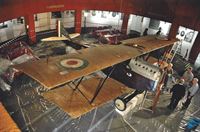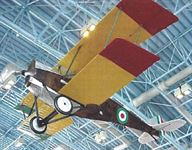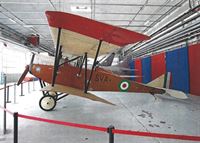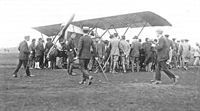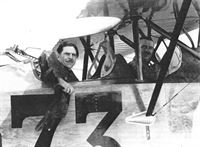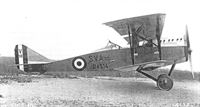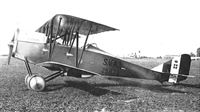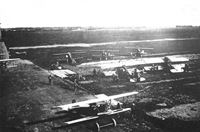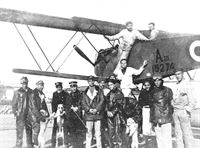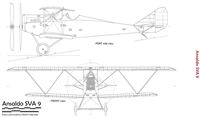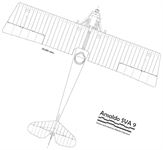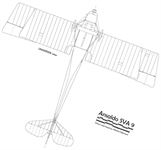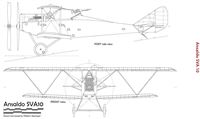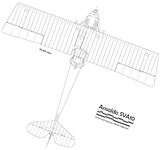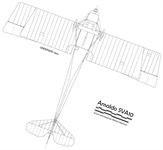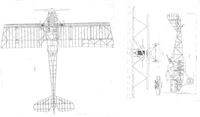В.Шавров История конструкций самолетов в СССР до 1938 г.
"Ансальдо" CBA-10 - двухместный разведчик с двигателем СПА в 220л. с., с той же конструкцией фюзеляжа и жесткой коробкой крыльев, имевший три пары диагональных раскосов - обтекаемых стальных труб. Было приобретено 50 экземпляров этого самолета, но и раньше он был у нас как трофейный (в том числе трехместный экземпляр).
Самолет||CBA-10
Год выпуска||1920
Двигатель , марка||СПА
мощность, л. с.||220
Длина самолета, м||8,1
Размах крыла, м||9,1
Площадь крыла, м2||26,9
Масса пустого, кг||730
Масса топлива+ масла, кг||130+15
Масса полной нагрузки, кг||350
Полетная масса, кг||1065
Удельная нагрузка на крыло, кг/м2||39,4
Удельная нагрузка на мощность, кг/лс||4,8
Весовая отдача,%||31,4
Скорость максимальная у земли, км/ч||200
Время набора высоты 1000м, мин||4,8
Время набора высоты 2000м, мин||10
Время набора высоты 3000м, мин||17
Время набора высоты 5000м, мин||38
Потолок практический, м||5500
Продолжительность полета, ч.||3
Показать полностью
L.Andersson Soviet Aircraft and Aviation 1917-1941 (Putnam)
SVA 10
The Ansaldo SVA 10 owed its origins to the single-seat SVA 3, SVA 4 and SVA 5 and more directly to the two-seat SVA 9 reconnaissance and training aircraft, which were all designed by V Savoia and R Verduzio for the Ansaldo company. Powered by the six-cylinder liquid-cooled 220hp SPA 6A engine, the SVA 10 was described as a fast two-seat reconnaissance and light bombing biplane. The lower wings were of shorter span than the upper ones and there were ailerons only on the upper wings. The wings were connected by three pairs of diagonal streamlined steel-tube struts on each side and the plywood-covered fuselage featured the typical thin Ansaldo triangular cross section rear end. There were individual exhaust stubs for each cylinder on the starboard side of the metal engine cowling. The fin was of triangular planform as on other Ansaldo types. Armament consisted of one fixed forward-firing machine-gun, one flexible gun in the rear cockpit and light bombs. The SVA 10 served with the Italian Air Force from 1918 and was used in quantity by Latvia, Lithuania and Poland. It was also obtained in small numbers by or presented to Argentina, Chile, Holland, Paraguay, Peru, Uruguay and the USA.
The Ukraine acquired a small number of SVAs in 1920 and also bought one SVA S 1. Georgia probably received twenty to twenty-five SVA 10s in 1920. A first batch often was delivered to Tiflis in November 1920 and were test-flown there by the Ansaldo company pilot Lovadina. Some of these aircraft were captured by the Red Army and taken on charge by the RKKVF, including c/ns 566, 572 and 574, of which c/n 574 was fitted with the 250hp Isotta-Fraschini engine. The Soviet Government order for Ansaldo aircraft placed in 1922 included thirty new SVA 10s, ten each for the 9th and 10th aviaotryady and the Moscow Aviation School, but in the event the only ones delivered were the sixteen that arrived at Odessa on the steamer Patras early in May 1922 (c/ns 617, 677-686 and 751-755).
Fourteen of the new SVA 10s were assigned to the Rostov-based 9th and 10th Otdel'nye razvedivatel'nye aviatsionnye otryady, where they replaced Sopwith l 1/2-Strutters and other types, and two were assigned to the 1st Higher School of Pilots in Moscow. The 47th Otdel'nyi razvedivatel'nyi aviatsionnyi otryad, sometimes called the Otdel'nyi svodnyi Kavkazskii razvedivatel'nyi aviaotryad (Detached Composite Kaukasian Reconnaissance Squadron) was set up at Tiflis at the beginning of 1924 with these two machines, the three captured SVA 10s and a few Lebed XIIs. This unit became the 7th Otdel'nyi razvedivatel'nyi aviatsionnyi otryad in 1925 and the 44th Korpusnoi aviaotryad in 1926, but by then the SVA 10s had been replaced by R-1s. All but a few were written off in 1925. In addition to the units mentioned above, the Balilla-equipped 48th Aviaotrvad at Odessa had a single SVA 10.
The Ansaldo A 5 was a two-bay biplane with normal interplane struts in place of the Warren type wing strut arrangement used on the SVA 10. Wings from the Pomilio PE were mated to an SVA fuselage, and both single-seat and two-seat A 5s were built. They were intended for highspeed and strategic reconnaissance respectively, but were not adopted by the Italian Air Force. Although fitted with a more powerful 290hp Ansaldo E145 engine the A 5 was inferior to the SVA. Only a few were built and one of them seems to have been included in the Italian deliveries to Georgia or the Ukraine. A (captured) SVA identified as s/n 13203 was first used by the Istrebitel'naya Eskadril'ya and then by the Razvedivatel'naya Eskadril'ya of the Aviatsionnaya Eskadra No. 2 at Kiev and, although fitted with a 220hp SPA engine, this aircraft was probably identical to the Italian s/n 13203, which was of the A 5 model.
Ansaldo SVA 10s, February 1924
Unit S/n C/n
9th ORAO
1 683
2 684
3 685
4 755
5 752
6 754
7 686
10th ORAO
1 617
2 677
3 679
4 680
5 681
6 751
7 753
1st VySL
678
682
205-220hp SPA 6A
Span 9.1m; length 8.1m; height 2.65; wing area 26.9m!
Empty weight 730kg; loaded weight 1,080kg
Maximum speed 200km/h; climb to 1,000m in 3.5min; ceiling 4,800m; endurance 3hr
Показать полностью
J.Davilla Italian Aviation in the First World War. Vol.2: Aircraft A-H (A Centennial Perspective on Great War Airplanes 74)
SVA 9/10
The decision to not to use the SVA single-seaters as fighters led to their subsequent use in the reconnaissance and bomber roles. The Ansaldo company was presented with a unique opportunity when the much-anticipated SIA 7b proved to be a failure. It is not surprising the Ansaldo decided that a two-seat version of the SVA could more effectively accomplish the SIA 7b’s missions.
In early June 1917 an SVA was converted to a two-seater in order to permit testing to begin in frontline squadriglias by experienced crew. This was not a difficult conversion as it only required the creation of an observer’s cockpit by removing the fuel tank in the forward fuselage. The wing area was enlarged by increasing the spacing of the ribs by 0.16 m. The original aircraft retained the 205-hp SPA 6 engine There were two main variants: the SVA-9 was an unarmed trainer, while the SVA-10 was completely equipped for armed reconnaissance missions.
It is believed that 6803 was the serial of the first SVA 9. In July 1918 the SVA 10 two-seater was flown to the units for a day so pilots, observers, and mechanics could examine it.
It was flown to XII Gruppo’s airfields at Casoni and Castel di Godego by capitano Luigi Bourlot and osservatore capitano Felice Porro on 5 July. At the end of the demonstration capitano Martucci, commander of XII Gruppo, stated that in terms of speed, maneuverability, and field of vision for the crew, the two-seaters would be suitable for combat use. Furthermore, its armament would permit it to be operated over the front without a fighter escort.
The observers liked the interior layout in respect to the camera and radio equipment, but felt the rear machine gun mount limited the field of fire, particularly of the tail. The pilot’s cockpit had poor visibility ahead, and it would be difficult to exit the aircraft in the event of an emergency. The mechanics criticized the engine access and suggested that two doors be fitted the sides of the cowling.
On 7 July 1918, while at the Gruppo V base at Marcon, the demonstration aircraft crashed, killing capitano Bourlot. The sole SVA crashed due to engine failure and was lost; fortunately it was recognized that the aircraft’s design was not a contributing factor in the accident, and production was allowed to continue. The recommendations of the front-line units were taken into account, and a Lewis gun was placed on a ring mount, while the pilot was given two synchronized Vickers machine guns mounted on the forward fuselage.
The conclusion was that the new Ansaldo would be an excellent replacement for the unreliable SIA 7bs. However, once again, the Italian aviation industry was not up to the task. The SPA 6 engine would prove to be the SVA two-seater’s Achilles heal; problems with the motor would delay SPA 9/10 deliveries almost until the Armistice. As a result only enough SVAs arrived at the front to be used in the strategic reconnaissance role. The artillery squadriglias were left without a modern aircraft.�
Technical
Wings - double-girder, covered with linen. Two-span airfoil chamber with oblique stands, according to the Warren system, made of steel tubes with a drop cross-section. Such a system effectively transferred the stresses arising from the forces occurring in flight and on the ground, especially during landing. Warren’s truss provided greater rigidity and strength of the airfoil chamber. Unbalance ailerons were only on the upper wing. The wing surface area of the SVA-10 was slightly larger than that of the SVA-5; this was achieved by widening the chord.
Fuselage - a frame and longitudinal hull, covered with plywood, had a rectangular cross-section going back into a triangular one, with the apex pointing to the bottom.
Cockpit - shared (bath), SVA-9 two-seater with separate cockpits.
Tail - wooden construction with steel pipe girders. The tail surfaces were stiffened with struts.
Landing gear - two legs with a non-split axle. Bungee cord shock absorbers. Tail skid made of steel half spring.
Engine - in-line 6-cylinder SPA-6A, 162 kW (220 HP), water-cooled, front radiator, blocked. The fuel reserve of 210 cm3 was carried in the main tank of 180 cm3 plus 2 auxiliary tanks.
Armament - in the SVA-10 it consisted of one 7.7-mm Vickers machine gun and one movable, 7.7-mm Lewis machine gun on a semi-turntable mount.
The SVA-9 was unarmed; it could have a machine gun for training, fixed or movable. SVAs could carry a load of 60-75 kg bombs (six of either 10 kg or 12.5 kg). The bomb racks were mounted to the handles placed on the sides of the fuselage in front of the pilot’s cockpit, above the oval cut of the lower wings.
Equipment - SVAs equipped with a radio were powered by a propeller-driven generator located under the fuselage. In Polish aviation these were used on SVA-9 aircraft No. 12880. Two cameras with long focal length were placed in the hatch between the engine and the fuel tank.
Operational Service
Small numbers of SVA 10s entered service just before the end of the war.
The most famous mission for the type was, of course, the raid on Vienna, which was led by d’Annunzio riding as a passenger in the only SVA 10 included in the mission. The mission was a great success, and the SVA 10 was able to complete the entire mission, whereas several SVAs were forced to withdraw to technical issues (primarily with the engine).
A sezione of the new SVA 10 two-seaters was assigned to 87a, its missions determined by the Comando Supremo. During Vittorio Venetto, the SVA 10’s mission was to fly contact patrols to keep tabs on the location of the rapidly advancing Italian troops. Their duties would be to reconnoiter 30 km in front of the advancing troops to assess the defensive lines and artillery that lay ahead. They were also to contact these troops and determine the extent of their advance. It was assumed that the situation would be too fluid for photographic surveys to be of value.
Postwar
The most famous accomplishment of the two-seat SVAs postwar was the Rome to Tokyo flight carried out in several SVA 10s; it was another spectacular flight conceived by D’Annunzio. A virtual armada of military aircraft, including Caproni 5s, joined the SVA 10s as they set out for Tokyo. However, in the end it was only two SVA 9s (replacing two SVA 5s that were not delivered in time) that would complete the journey. SVA 9 12849 broke down during the journey and had to be replaced by 13148, but 13157 flew the entire route. 13148 was preserved by the Japanese.
The SVA units continued to employ a mix of single and two-seat aircraft.
Albania
The treaties provided for a united and independent Albania, except for Valona, considered indispensable for the control of the Adriatic, to be assigned to Italy, but Yugoslavia and Greece were not pleased with this arrangement. The war weary Italian troops had to deal with armed gangs and malaria. In order to help stabilize the situation, VIII Gruppo was assigned to the area. Its constituent units included 85a Squadriglia Hanriot at Piskupi, 1 Squadriglia Caproni and 63a Squadriglia PE / SAML and the SVA Sezione of Valona, the latter was engaged in postal flights between the various cities of the country.
In September 1919, the Aviazione deployed VIII Gruppo forming a Squadriglia Mista (Mixed Squadron) with eight fighters and six reconnaissance which flanked the Caproni Squadriglia 1 and an Sezione Autonoma (Autonomous Section) in Durres.
In May 1920 the Italians withdrew to the coastal cities; the other occupying forces had withdrawn. The Italian aerial forces were commanded by maggiore Aurelio Liotta, former commander of VIII Gruppo and at the end of June he was assigned, on paper, six Capronis, eight SVAs, and two dirigibles.
I n the spring of 1922 after a conference in Paris for the settlement of the Greek-Turkish conflict and the reorganization of the Levant, the Italian troops were withdrawn from Anatolia.
Balkans
In the Balkans the Italian 35th Divisione, on the Macedonian front, which in April 1919 became the Italian Expeditionary Turkey also had an Italian presence, with a regiment in Constantinople. The last Italian troops left Anatolia in May 1922.
At the beginning of 1920 8a Armata was a garrison army on the eastern border with only 106,000 men, but it had five bombers, 32 fighters, 20 reconnaissance, and 10 SVA bombers.
Libya
The SVA-10s saw service in Libya. At the end of November 1918, the units in Libya with SVA 10s included 89a and 90a Squadriglias with 19 SVAs of various types, plus an independent sezione with SVA 10s.
In the Spring of 1919, the Libyan-based units came under XXII Gruppo. They included 89a (5 SVAs) at Homs, 90a (5) at Mellaha, and a Sezione SVA biposto (two seaters).
In 1922 104a Squadriglia was based at Cirenaica with M.F.11s and during the year re-equipped with SVAs at Malpensa. It subsequently moved to Bengasi. In 1925 104a was replaced by 26a and 37a Squadriglias. 16a and 23a Squadriglias are also known to have used SVA two seaters, although these units used a mix of single and two-seat SVAs.
They SVA-10s were not replaced until 1930 when IMAM Ro.Is (Fokker C.Vs built under license) became available.
Foreign Service
Argentina - On 30 November 1918 the Italian government formed 350a Squadriglia, which was intended to demonstrate Italian aircraft available for sale. The unit was sent to Buenos Aires and included the Isotta Fraschini V6-powered SVA 10 serial 13164; although some sources suggest that a second SVA 10 was sent, Argentinian sources confirm only one arrived. The sole SVA 10 was assigned to Grupo I de Aviacio/Grupo I de Obs.
Brazil - The largest Latin American customer was Brazil; the Brazilian navy acquired 18 SVA 10s which remained in service with the Flotilla de Reconecimento (Reconnaissance squadron) until at least 10 January 1927. The SVA were initially operated as 780-797, which seem to be Ansaldo construction numbers, but later the surviving five aircraft became 211 to 215, which were definitely Brazilian serials.
Chile - In December 1920 Chile had one SVA. The Chilean machine was a 'Tokyo’ type SVA 10, c/n 496, donated to the Army by Italian residents in 1919 as Capitan Pastine. It was wrecked at Puchuncavi on 30 June 1923. There is no record of this aircraft in the official history of the Chilean air force, or other sources; perhaps it was only used as a civilian machine.
China - In 1920 during the Italian Rome-Tokyo flight with seven SVA 9s, 13157, crashed at Canton and was left there. On 25 February 1921 one of the SVA 9s brought to China in 1920 was presented to the Government and placed in the Historical Museum at Wu Men Lao in Peking.
In 1925, when Feng Yuxiang formed the Northwest Air Force, he bought 12 SVA 5 and 9 aircraft. In May of the following year, one SVA 9 was lost in Zhangjiakou; the plane crashed and the crew were killed. The history of the planes is undocumented.
Another example was constructed by a Mr Christiansen, Canton, from the spares left behind by the Italians and it is likely that the machine that crashed at Canton was used as well. This aircraft was sold to Yunnan in 1923, but crashed on its first flight.
In 1925, when Feng Yuxiang formed the Northwest Air Force and bought a mix of 12 SVA 5 and 9 aircraft. In May of the following year, one SVA 9 was lost in Zhangjiakou; the plane crashed and the crew were killed.
Czechoslovakia - SVA 9s were obtained for the Czech Air Force when, after the declaration of independence, two Czech pilots from Italy returned home with two SVAs. Their machines were based at Nitra and Olomouc. The Czech Air Force also had one SVA 10 which had been left after the departure left by the Italian military mission.
Ecuador - The Ecuadorian SVA 10, was a gift to the Army by the Italian colony in Guayaquil, arrived on 19 February 1921 on the steamer SS Europa. It was assigned to the Escuela de Aviacion, along with a SAML S.2 (reported in Ecuadorian sources as an “Aviatik”).
The SVA 10 had the honor of making the first flight for the Escuela de Aviacio piloted by Elia Liut with passenger Rafael Frugone who was a representative of the Italian colony.
In Duran, on October 1,1928, Captain Agustin Zambrano Barreiro made a test flight of an SVA 10 that had undergone total repair, but at 300 meters the engine stopped, plummeting, crashed and killed the pilot.
Georgia - After buying a sample SVA 10, in July 1920, the republic of Georgia ordered between twenty to twenty-five SVA 10s in 1920. A first batch of ten was delivered to Tiflis in November 1920.
Japan - One SVA 9 that had reached Tokyo during the Rome to Tokyo flight, aircraft no. 13148, was donated by the Italian government to the Japanese Army. The aircraft was displayed at the Yushukan in Tokyo Kudan. It was later used as an instructional airframe at the Flight School. A restored machine was donated to the Japanese Air Self-Defense Force and is still stored.
Latvia - Latvia acquired SVA 10s in 1923; known serial numbers are 4K, 5K, 6K, 29, 30, 33, 38, 40, 41. However, only four aircraft were actually purchased: one addition aircraft (33) was constructed in the aviation division’s workshops. The other four serial numbers (30, 38, 40, and 41) were the original four airframes renumbered.
The Italian aircraft were phased out in the early 1930s, being replaced by the Gladiators, Hinds and SV 5s.
4K - Original serial no. 776; August 26-30,1924 - participated in Latvia’s first goodwill tour, a four-day visit to Tallin, Estonia.
5K - Original serial no. 777; August 26-30,1924 - participated in Latvia’s first goodwill tour, a four-day visit to Tallin, Estonia.
6K - Original serial no. 778; August 26-30,1924 - participated in Latvia’s first goodwill tour, a four-day visit to Tallin, Estonia.
29 - Original serial no. 779
33 - in 1928 - this aircraft was constructed in the aviation division workshops from spare parts.
38 - July 6,1928 the aircraft crashed injuring the crew.
40 - October 30,1928 crashed, injuring the crew
41- had a major overhaul in 1926
The SVA 10s were phased out in the early 1930s, being replaced by the Gladiators, Hinds and Stampe Vertognen SV-5s.
Lithuania - 1923 Lithuania bought 10 SVA 10 (No. 799-808) reconnaissance aircraft and spare parts for them for 745,000 lira from Aeronautica Ansaldo Societa Anonimo di Torino. Delivered to Kaunas on June 3, seven assembled planes had been completed and test flown by 9 June. The planes were bought unarmed in 1925. Subsequently, one Vickers machine gun for the pilot and one camera were installed.
These were than sent to the 2-ajaj eskadrieli (2nd Squadron) of the Karo Aviacija (Lithuanian Air Force). The planes served until 1930. Another five SVA 10s were produced in the Aviation Workshop in 1928-29.
According to Alegi, some may have gone to 3-ajaj eskadrieli (3rd Squadron); they were SOC before 1930.
Mexico - purchased one SVA 10 in 1923. It was coded 2-D-80.
Netherlands - On 24 August 1919 the Italian government offered two SVA 10s to the Dutch government. The first aircraft was SVA 10 SVA483, which arrived on 24 August at Soesterberg, whereas the second, SVA484, arrived months later. These aircraft were used in the liason role by the LVA. The version which the LVA received had a 250-hp Isotta-Fraschini I.F.V6 engine, There was a synchronized 7,7- mm Vickers machine gun and a second Lewis gun on the observer’s ring mount. SVA484 was SOC in 1923 or 1924, followed by SVA483 in 1925.
Paraguay - During the 1922 civil war in Paraguay, the government and rebel forces each operated a single SVA10.
The rebels began hiring foreign pilots; the first mercenary aviator to be hired was sergente Angelo Pescarmona, an Italian veteran pilot of the First World War, who owned an Ansaldo SVA 10. When he crash landed in Vilarrica, he destroyed the machine, but was unharmed.
Another SVA 10 was left on the ground due to lack of technical repairs and was captured. The SVA 10 survived the conflict and was sent to the EMA (Military Aviation School) at Campo Grande, where it received serial No. 1. It is believed to have survived until 1930.
The government machine, possibly coded '2’, was operated from Nu-Guazu (Campo Grande) and survived at least until February 1923. In several reconnaissance missions with the SVA 10, Sgt. Bo was accompanied by a Captain named Fernandez, as well as Agustin Cusmanich.
Peru - In summer 1920 Maurice Mott bought a two-seat SVA and an A.300/3 in New York. A former US military pilot who had served in France, on 20 July Mott paid $3,800 for the SVA, which he then took to Peru. This led a Mr. De Marzi of the Menicucci shipping company to order two Balillas, two SVA 5s and two A.300/3s direct from Ansaldo, in December 1920. However, other sources report four SVA 10s and eight A.300s sold to Peru. However, the claim of four SVA 10s being sent to Peru appears to be erroneous. The official history of Peruvian military aircraft lists only SVA 5s, Ansaldo A.300s, and A.1 Balillas.
Poland
SVA 9
Capitano Luigi Mainardi flew his SVA 9 (no.12880) from Rome to Warsaw, via Udine and Vienna, in 9 hours, 25 minutes, carrying a member of the Polish legation in Rome accompanied by Tenente Giannino Ancillotto in a single seat SVA 5.
It was a two seater, basically unarmed, although it was alternatively equipped with an installation for the engine Vickers and a semi-turntable in the second cabin in a rear passenger cabin. It could therefore be used as a long-range liaison aircraft. The SVA 9 was demonstrated at the following airports: Mokotow, Lawica, and Rakowice. In the spring of 1921, it was assigned to 12 EW, then equipped with SVA 10s. In the years 1922-23 it was in the Exercise Section 2 PL, from where it was withdrawn to a warehouse in the Parku lotniczym (Aviation Park) in 1923.
SVA-10
In the years 1920-1921, 90 SVA aircraft were brought to Poland. The first contract of 27 February, 1920 for the supply of 40 SVA 10 between GUZA and the Ansaldo was signed on 24 April 1920. There was a signed second contract for the delivery of another 40 SVA 10s approved by Lieutenant General E. Katkowski on August 30, 1920.
By December 20, 1920 the first 12 were received, and the rest by 30 August, 1921. All planes were picked up at the airport in Krakow. However, the serial list 30 SVAs, of which 26 were SVA 10s, three SVA 5s and one SVA 9. From regular deliveries ensured by contracts, 80 SVA 10 were marked with numbers from SVA.1 to SVA.80 in the park’s workshops 2 PL.
The introduction of SVA-10 aircraft to the Polish military began badly. The Italians demonstrated SVA 10 No. 12765 at the beginning of February at the Rakowicki airport in Krakow. During a mock attack on 6 February 1920, as a result of the pilot’s failure to exercise caution, four soldiers from the 2nd Battalion died. The plane was badly damaged. However, this was due to the Italian’s excessive bravado and the incident did not affect the decision to order the planes.
The SVA 10 aircraft entered service after the Polish-Bolshevik war in 1921. They equipped 12 EW with 1 EL and 6 and 14 EW from 2 PL. In 1922, eight more arrived and were transferred from Lida to 2 PL in August. Some were used by the WSP (Military Police) and military school at Grudziadz (which used them until 1933). Most of the planes, however, were gathered in Krakow As of August 30,1922, there were 81 SVA 10s in 2 PL, including 66 in the Park depot, 11 with operational units and four ready for scrapping.
There was a series of SVA-10 accidents on 4 June, 20 June, 21 November 1921, 20 June 1922, and 12 April 1923. As a result of these crashes eight airmen were killed and five aircraft were SOC. The accidents occurred mostly in 14 EW and in Park 2 PL during the overhaul flight. The causes of the accidents were: wing tearing off (two), pilot error (one) and circumstances difficult to determine, but probably design flaws (two). In addition, there were more and more structural breakdowns, especially when performing acrobatics. The airplanes had deformed wings after landing and would require a major overhaul. On April 17,1923, SVA 10 flights were suspended, and the head of Dep. IV Z. P. col. pil. Armand Leveque ordered the destruction of the damaged airframes. In view of the negative results of the test, Dep. IV Z P ordered that on May 11,1923 all 67 SVA 10s in regiments and aviation schools, were to be withdrawn from use.
At the end of September 1923, the Ansaldo team from Turin arrived in Krakow with SVA 10 and A 300-4 aircraft in order to demonstrate their flight properties and improve the image of SVA aircraft in the eyes of Poles. The SVA 10’s pilot was Rolandi, and he flew the two seater in Warsaw and Krakow at the beginning of September 1923. This did not help much, because the order forbidding flying on damaged airframes was not withdrawn and a year later, on September 1, 1924, none of the squadrons was equipped with SVA 10 aircraft. The last 31 were deleted in CSL Dublin on May 20, 1927.
Soviet Union - A total of 25 Georgian SVA 10s were captured by the Red Army after the annexation of that country in 1922. Known serials include c/ns 566, 572 and 574, of which c/n 574 was fitted with the 250hp Isotta-Fraschini engine.
The Soviet Government placed an order with Ansaldo in 1922 for thirty new SVA 10s, ten each for the 9th and 10th aviaotryady and the Moscow Aviation School, but in the event the only ones delivered were the sixteen that arrived at Odessa on the steamer Patras early in May 1922 (c/ns 617, 677-686 and 751-755).
The aircraft were used by:
- 17th Separate Air Detachment - Western Military District
- Black Sea Air Forces - 1st and 2nd Reconnaissance Detachments
- Trans Caucasus Military District
According to Andersson, fourteen went to the Rostov-based 9th and 10th Otdel’nye razvedivatel’nye aviatsionnye otryady, where they replaced Sopwith 1 1/2-Strutters and other types, and two were assigned to the 1st Higher School of Pilots in Moscow.
The 47th Otdel’nyi razvedivatel’nyi aviatsionnyi otryad (Detached Composite Kaukasian Reconnaissance Squadron) was set up at Tiflis at the beginning of 1924 with two Ansaldo SVA 10s, the three captured SVA 10s and a few Lebed XIIs.This unit became the 7th Otdel’nyi razvedivatel’nyi aviatsionnyi otryad in 1925 and the 44th Korpusnoi aviaotryad in 1926, but by then the SVA 10s had been replaced by Polikarpov R-1s. All but a few were written off in 1925.
One SVA 10 served with the 48th Aviaotryad at Odessa.
A (captured) SVA identified as s/n 13203 was first used by the Istrebitel’naya Eskadril’ya and then by the Razvedivatel’naya Eskadril’ya of the Aviatsionnaya Eskadra No. 2 at Kiev and, although fitted with a 220hp SPA engine.
Ukraine - acquired a small number of SVAs in 1920. Some sources suggest that the actual Ukrainian order was limited to ten SVA 10; some of these later fell in Soviet hands.
United States - On On 18 December 1919 the Ansaldo offices in New York requested a two-seat SVA fuselage, complete with controls and centre-section struts but without undercarriage and engine, This may have been intended for the Aero Import Corporation (AIC).The company went out of business on 31 December 1921.
Alegi suggests that up to 70 SVA and A.300 may have reached the United States, either for promotional reasons or for resale to other (presumably South American) countries. No military orders were forthcoming.
SVAs participated in the 1920 Pulitzer Trophy Race at Mitchell Field, the 1921 American Legion Air Derby in Kansas City, the second Pulitzer Trophy Race on 3 November.
Uruguay - On July 30,1920 an Ansaldo SVA 10 was donated to Cap. Berisso of the Escuela Militar de Aviacion so that he could carry out long distance flights. This SVA 10, serial no.1, was named Uruguay was assembled by the Italian mechanic Mr. Gino Dolci. It had been paid for by a popular collection initiated by Messrs. Andres Carril and Luis Conti in the month of March 1920. After test flights over the Mendoza Aerodrome and a flight to San Ramon with a mechanic on September 3, Capt. Berisso accompanied by the mechanic Dolci, carried out a long distance flight on September 10 to the city of Mel and landed in the current field of the Centauro Polo Club before arriving at the cavalry barracks.
Cap. Berisso made other long distance flights during 1920. However, Uruguay, proved difficult to maintain in service and in September 1921 suffered an accident and had to be rebuilt in the school’s workshops.
The Uruguayan army obtained two more SVA 10s in 1925 by popular subscription and both were used by the Escuela Militar de Aviacion. These aircraft were No.2 (Fray Bentos), which flew on 15 June 1925 and No. 4 Flores on 25 August. Between 13-19 May 1926 Teniente Oscar D Gestido accompanied by mechanic Dagoberto Moll, flew No.4 from Montevideo to Asuncion and back, to salute the Paraguayan independence day.
‘Flores’was lost in February 1928, but 'Uruguay’survived to make a final nine minute flight on 14 September 1931 piloted by the man who had made the type so popular in Uruguay, Tte. Cnel. Cesareo Berisso.
Yemen - In 1924 Imam Yahya’s Air Force asked for the supply two aircraft and two instructors. A contract was signed on 6 January 1926 to deliver six aircraft to Yemen. In March three of them arrived on the Italian ship ‘Lomedano’. The other three arrived in April. One report stated that they were a gift from Italy.
The Imam complained officially about the condition of these aircraft and said that they were unable to fly any distance without breaking down. In July 1926 the Italian Government of Eritrea agreed to send better aircraft to Yemen; in August one machine, arrived at Hodeidah.This one was a present from the Italian Governor of Eritrea. The aircraft were assembled by the Italian pilot Schiona.
Andersson believes that two of these aircraft were SVA 9 or 10s. The other machines were believed to be one Hanriot HD.1s, one or two SAML S2s, one Ansaldo A.1 Balilla fighter, two SAML S2s, one Hanriot HD.1 and one of an unknown type.
SVA 9 two seat trainer with one 205-hp SPA 6A engine
Wingspan 9.100 m; length 8.100 m; height 2.650 m; wing area 26.90 sq m
Empty weight 690 kg; loaded weight 965 kg; payload 275 kg
Maximum speed 219 km/h at low altitude; climb to 1,000 m in 3 minutes; 2,000 m in 7 minutes; 3,000 m in 13 minutes; 4,000 m in 21 minutes; 5,000 m in 35 minutes; endurance 3 hours
SVA 10 two seat reconnaissance aircraft with one 205-hp SPA 6A engine
Wingspan 9.243 m; length 8.100 m; height 2.720 m; wing area 26.90 sq m
Empty weight 730 kg; loaded weight 1,065 kg; payload 335 kg� Maximum speed 195 km/h; climb to 1,000 m in 3 minutes 55 seconds; 2,000 m in 8 minutes 6 seconds; 3,000 m in 15 minutes 30 seconds; 4,000 m in 23 minutes 50 seconds; ceiling 4,800 m; endurance 3 hours 10 minutes
SVA 10 two seat reconnaissance aircraft with one 250-hp Isotta Fraschini V6 engine
Wingspan 9.100 m; length 8.120 m; height 2.650 m; wing area 26.90 sq m
Empty weight 760 kg; loaded weight 1,100 kg; payload 350 kg
Maximum speed 199 km/h; climb to 1,000 m in 3 minutes; 2,000 m in 6 minutes 10 seconds; 3,000 m in 10 minutes 10 seconds; 4,000 m in 16 minutes; 5,000 m in 24 minutes 10 seconds ceiling 5,800 m; endurance 2 hours 15 minutes
SVA 10 two seat reconnaissance aircraft with one 250-hp Isotta Fraschini Mezzo Asso engine
Wingspan 9.243 m; length 8.180 m; height 2.860 m; wing area 27 sq m
Empty weight 894 kg; loaded weight 1,294 kg; payload 400 kg
Maximum speed 215 km/h at low altitude; climb to 1,000 m in 4 minutes; 2,000 m in 9 minutes 45 seconds; 3,000 m in 17 minutes; 4,000 m in 27 minutes; endurance 4 hours 15 minutes
Ansaldo AM
The Ansaldo AM (Ansaldo Marino) was a single-seat floatplane based on the Ansaldo two seat SVA 9/10 aircraft. The floats which constructed as plywood cylinders with flat ends and a single step. There were steel rings fixed to the cylindrical part of the float in order to increase its strength. The cylindrical shape was unlike other floatplane designs that had flat bottomed floats. Ansaldo felt that this design feature would facilitate takeoff from either quiet or rough seas. There were two rudders at the end if the floats used for steering on the water. A special device allowed the engine to be started by the pilot while on board the aircraft.
Armament was two synchronized Vickers machine guns.
Ansaldo reported that company tests revealed the AM could reach 200 km/h and climb to 6,000 m with a full payload in just over half an hour.
Показать полностью


















